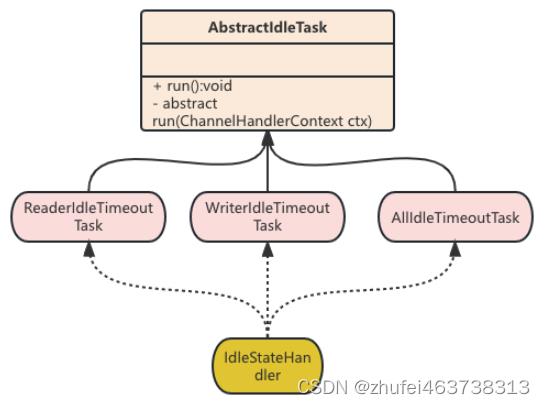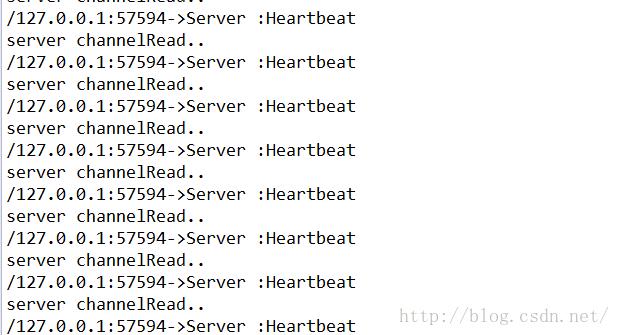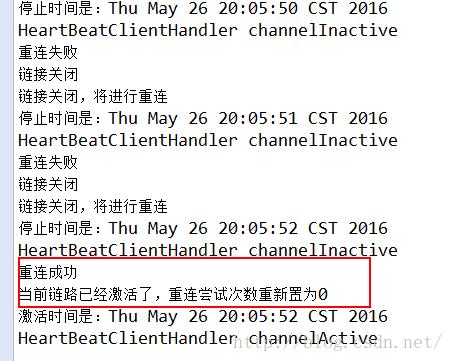netty入门(二十四)Netty心跳机制源码剖析
Posted zhufei463738313
tags:
篇首语:本文由小常识网(cha138.com)小编为大家整理,主要介绍了netty入门(二十四)Netty心跳机制源码剖析相关的知识,希望对你有一定的参考价值。
1.源码剖析的目的
Netty作为一个网络框架,提供了诸多功能,比如编码解码等,Netty 还提供了非常重要的一个服务 ---- 心跳机制 heartbeat。通过心跳检查对方是否有效,这在 RPC 框架中是必不可少的功能。下面我们分析一下 Netty 内部 心跳服务源码的实现。
2.源码解析使用案例
2.1 源码案例
public class MyServer
public static void main(String[] args) throws InterruptedException
// 创建两个线程组
NioEventLoopGroup bossGroup = new NioEventLoopGroup(1);
NioEventLoopGroup workerGroup = new NioEventLoopGroup(8);
try
ServerBootstrap serverBootstrap = new ServerBootstrap();
serverBootstrap.group(bossGroup, workerGroup)
.channel(NioserverSocketChannel.class)
.handler(new LoggingHandler(LogLevel.INFO)) // 在bossgroup增加一个日志处理器
.childHandler(new ChannelInitializer<SocketChannel>()
@Override
protected void initChannel(SocketChannel ch) throws Exception
ChannelPipeline pipeline = ch.pipeline();
// 加入 netty 提供的 IdleStateHandler
/**
* 说明
* 1. IdleStateHandler 是 netty 提供的处理空闲状态的处理器
* 2. readerIdleTime:表示多长时间没有读,就会发送一个心跳检测包,检测是否还是连接状态
* 3. writerIdleTime:表示多长时间没有写,就会发送一个心跳检测包,检测是否还是连接状态
* 4. allIdleTime:表示多长时间没有读写,就会发送一个心跳检测包,检测是否还是连接状态
* 5. 当 IdleStateEvent 触发后,就会传递给管道的下一个handler进行处理,通过调用(触发)下一个 handler 的userEventTrigged 方法,
* 在该方法中去处理 IdleStateEvent 事件
*/
pipeline.addLast(new IdleStateHandler(3,5,7, TimeUnit.SECONDS));
// 加入一个对空闲检测进一步处理的handler(自定义)
pipeline.addLast(new MyServerHandler());
);
ChannelFuture channelFuture = serverBootstrap.bind(7000).sync();
channelFuture.channel().closeFuture().sync();
finally
bossGroup.shutdownGracefully();
workerGroup.shutdownGracefully();
/**
* 心跳处理器
*/
public class MyServerHandler extends ChannelInboundHandlerAdapter
/**
*
* @param ctx 上下文
* @param evt 事件
* @throws Exception 异常
*/
@Override
public void userEventTriggered(ChannelHandlerContext ctx, Object evt) throws Exception
if(evt instanceof IdleStateEvent)
// 将 evt 向下转型
IdleStateEvent event = (IdleStateEvent) evt;
String eventType = null;
switch (event.state())
case READER_IDLE:
eventType = "读空闲";
break;
case WRITER_IDLE:
eventType = "写空闲";
break;
case ALL_IDLE:
eventType = "读写空闲";
break;
System.out.println(ctx.channel().remoteAddress() + "--超时事件发生-->" + eventType);
System.out.println("服务器做相应处理......");
如上源码中,我们对 Netty 服务器的(读/写)活动情况进行监听,利用 IdleStateHandler 来完成,其中三个参数分别读、写、读/写 空闲时间。
2.2介绍
Netty 提供了 IdleStateHandler ,ReadTimeoutHandler,WriteTimeoutHandler 三个 Handler 检测连接的有效性。
ReadTimeout 事件和 WriteTimeout 事件都会自动关闭连接,而且,属于异常处理,所以,重点分析IdleStateHandler。
序号 | 名称 | 作用 |
1 | IdleStateHandler | 当连接的空闲时间(读或者写)太长时,将会触发一个 IdleStateEvent 事件。然后你可以通过你的 ChannelInboundHandler 中重写 userEventTrigged 方法来处理该事件。 |
2 | ReadTimeoutHandler | 如果在指定的时间没有发生读事件,就会抛出这个异常,并自动关闭这个连接。你可以在 exceptionCaught 方法中处理这个异常。 |
3 | WriteTimeoutHandler | 当一个写操作不能在一定的时间内完成时,抛出此异常,并关闭连接。你同样可以在 exceptionCaught 方法中处理这个异常。 |
ReadTimeout 事件和 WriteTimeout 事件都会自动关闭连接,而且,属于异常处理,所以,这里只重点介绍IdleStateHandler。
3.IdleStateHandler分析
首先,当调用 addLast 添加 IdleStateHandler 到 pipeline 中时,会触发 handlerAdd 方法
// 添加操作
pipeline.addLast(new IdleStateHandler(3,5,7, TimeUnit.SECONDS));
// 该方法
@Override
public void handlerAdded(ChannelHandlerContext ctx) throws Exception
if (ctx.channel().isActive() && ctx.channel().isRegistered())
// channelActive() event has been fired already, which means this.channelActive() will
// not be invoked. We have to initialize here instead.
initialize(ctx);
else
// channelActive() event has not been fired yet. this.channelActive() will be invoked
// and initialization will occur there.
关注 initialize 方法,如下代码中,对 IdleStateHandler 的属性进行初始化过程,涉及到以下几个。
private void initialize(ChannelHandlerContext ctx)
// Avoid the case where destroy() is called before scheduling timeouts.
// See: https://github.com/netty/netty/issues/143
switch (state)
case 1:
case 2:
return;
state = 1;
initOutputChanged(ctx);
lastReadTime = lastWriteTime = ticksInNanos();
if (readerIdleTimeNanos > 0)
readerIdleTimeout = schedule(ctx, new ReaderIdleTimeoutTask(ctx),
readerIdleTimeNanos, TimeUnit.NANOSECONDS);
if (writerIdleTimeNanos > 0)
writerIdleTimeout = schedule(ctx, new WriterIdleTimeoutTask(ctx),
writerIdleTimeNanos, TimeUnit.NANOSECONDS);
if (allIdleTimeNanos > 0)
allIdleTimeout = schedule(ctx, new AllIdleTimeoutTask(ctx),
allIdleTimeNanos, TimeUnit.NANOSECONDS);
private final boolean observeOutput; : 是否考虑出站时候较慢的情况,默认是false
private final long readerIdleTimeNanos; : 读事件空闲时间,0 则禁用事件
private final long writerIdleTimeNanos; : 写事件空闲时间,0 则禁用事件
private final long allIdleTimeNanos; : 读/写事件空闲时间,0 则禁用事件
源码中,当参数 > 0 时,就创建一个定时任务,每个事件都创建,同时将 state 设置为1,避免重复初始化,调用 initOutputChanged 方法初始化监控出站数据属性。
创建定时任务源码如下,利用 channel 中的 EventLoop 来添加一个 Scheduler,看源码并 debug,观察 EventLoop 中 Scheduler 线程池中是否有新增任务,如下:
ScheduledFuture<?> schedule(ChannelHandlerContext ctx, Runnable task, long delay, TimeUnit unit)
return ctx.executor().schedule(task, delay, unit);
在 ScheduledTaskQueue 中的确有3个Task,因为 addLast 的方法中有三个参数都被初始化了,那么我们来看下对应的三个 Task 实现方法。
三个 Task 都是 ChannelDuplexHandler 中的内部类,并且有一个共同父类, AbstractIdleTask
private abstract static class AbstractIdleTask implements Runnable
private final ChannelHandlerContext ctx;
AbstractIdleTask(ChannelHandlerContext ctx)
this.ctx = ctx;
@Override
public void run()
if (!ctx.channel().isOpen())
return;
run(ctx);
protected abstract void run(ChannelHandlerContext ctx);
AbstractIdleTask内部类设计用来单例模式,模板模式UML如下

模板方法的通用流程:当通道关闭,就不执行任务,反之则执行抽象方法 run 方法,
3.1 读事件 task 分析
先看 ReaderIdelTimeoutTask 方法中的 run 方法的实现
private final class ReaderIdleTimeoutTask extends AbstractIdleTask
ReaderIdleTimeoutTask(ChannelHandlerContext ctx)
super(ctx);
@Override
protected void run(ChannelHandlerContext ctx)
long nextDelay = readerIdleTimeNanos;
if (!reading)
nextDelay -= ticksInNanos() - lastReadTime;
if (nextDelay <= 0)
// Reader is idle - set a new timeout and notify the callback.
// 用于取消任务 promise
readerIdleTimeout = schedule(ctx, this, readerIdleTimeNanos, TimeUnit.NANOSECONDS);
boolean first = firstReaderIdleEvent;
firstReaderIdleEvent = false;
try
// 再次提交任务
IdleStateEvent event = newIdleStateEvent(IdleState.READER_IDLE, first);
// 触发用户 handler use
channelIdle(ctx, event);
catch (Throwable t)
ctx.fireExceptionCaught(t);
else
// Read occurred before the timeout - set a new timeout with shorter delay.
readerIdleTimeout = schedule(ctx, this, nextDelay, TimeUnit.NANOSECONDS);
说明:
(1)得到用户设置的超时时间。
(2)如果读取操作结束了(执行了 channelReadComplete 方法设置),就用当前时间减去给定时间和最后一次读(执行了操作的时间 channelReadComplete 方法设置),如果小于 0 ,就触发事件。反之,继续放入队列。间隔时间是新的计算时间。
(3)触发的逻辑是:首先将任务再次放到队列,时间是刚开始设置的时间,返回一个 promise 对象,用于做取消操作。然后,设置 first 属性为 false,表示下一次读取不是第一次了。这个属性在 channelRead 方法会被改成 true。
(4)创建一个 IdleStateEvent 类型的写事件对象,将此对象传递给用户的 UserEventTriggered 方法。完成触发事件的操作。
(5)总的来说,每次读取操作都会记录一个时间,定时任务时间到了,会计算当前时间和最后一次读的时间的间隔,如果间隔超过了设置的时间,就出发 UserEventTriggered 方法。
3.2 写事件 task 分析
写事件的run方法WriterIdleTimeoutTask, 和读事件的差不多,如下有一点区别
private final class WriterIdleTimeoutTask extends AbstractIdleTask
WriterIdleTimeoutTask(ChannelHandlerContext ctx)
super(ctx);
@Override
protected void run(ChannelHandlerContext ctx)
long lastWriteTime = IdleStateHandler.this.lastWriteTime;
long nextDelay = writerIdleTimeNanos - (ticksInNanos() - lastWriteTime);
if (nextDelay <= 0)
// Writer is idle - set a new timeout and notify the callback.
writerIdleTimeout = schedule(ctx, this, writerIdleTimeNanos, TimeUnit.NANOSECONDS);
boolean first = firstWriterIdleEvent;
firstWriterIdleEvent = false;
try
if (hasOutputChanged(ctx, first))
return;
IdleStateEvent event = newIdleStateEvent(IdleState.WRITER_IDLE, first);
channelIdle(ctx, event);
catch (Throwable t)
ctx.fireExceptionCaught(t);
else
// Write occurred before the timeout - set a new timeout with shorter delay.
writerIdleTimeout = schedule(ctx, this, nextDelay, TimeUnit.NANOSECONDS);
不通地方在于,run代码中多了一个判断hasOutputChanged 用来判断出站事件处理是否很慢,例如,我一个出站需要写的数据量大,需要处理20秒,但是我们执行写事件监测的时间是 5秒,此时我们只有第一次会触发,因为 hasOutputChanged 中有判断first 的时候还是会执行异常抛出
3.3 所有事件(读/写)事件 task 分析
private final class AllIdleTimeoutTask extends AbstractIdleTask
AllIdleTimeoutTask(ChannelHandlerContext ctx)
super(ctx);
@Override
protected void run(ChannelHandlerContext ctx)
long nextDelay = allIdleTimeNanos;
if (!reading)
nextDelay -= ticksInNanos() - Math.max(lastReadTime, lastWriteTime);
if (nextDelay <= 0)
// Both reader and writer are idle - set a new timeout and
// notify the callback.
allIdleTimeout = schedule(ctx, this, allIdleTimeNanos, TimeUnit.NANOSECONDS);
boolean first = firstAllIdleEvent;
firstAllIdleEvent = false;
try
if (hasOutputChanged(ctx, first))
return;
IdleStateEvent event = newIdleStateEvent(IdleState.ALL_IDLE, first);
channelIdle(ctx, event);
catch (Throwable t)
ctx.fireExceptionCaught(t);
else
// Either read or write occurred before the timeout - set a new
// timeout with shorter delay.
allIdleTimeout = schedule(ctx, this, nextDelay, TimeUnit.NANOSECONDS);
与写事件基本一致,不同地方在于事件判断
nextDelay -= tickInNanos() - Math.max(lastReadTime, lastWriteTime);当前时间-最后一次写/读的时间,如果>0说明超过了
此处的时间判断是取读,写事件中的最大值,然后像写事件一样,判断是否发生了写很慢的情况
4.Netty心跳机制总结
(1)IdleStateHandler 实现心跳检测功能,当服务器和客户端没有任务读写,并且超过设置事件,会触发 handler 的 userEventTriggered 方法,用户可以在这个方法中实现自己的逻辑。
(2)IdleStateHandler 的实现基于 EventLoop 的定时任务,每次读写都会记录一个值,在定时任务运行的时候,通过计算当前时间和设置时间和上次事件发生时间的结果,来判断是否空闲。
(3)内部有 3 个定时任务,分别对应读事件、写事件、读写事件。通常用户监听读写事件就足够了。
(4)同时,IdleStateHandler 内部也考虑了一些极端情况:客户端接收缓慢,一次接收数据的速度超过了设置的空闲时间。Netty 通过构造方法中的 observeOutput 属性来决定是否对出站缓冲区的情况进行判断。
(5)如果出站缓慢,Netty 不任务这是空闲,也就不触发空闲事件。但第一次无论如何也是要触发的。因为第一次无法判断是出站缓慢还是空闲。当然,出站缓慢的话,可能造成 OOM,OOM比空闲的问题更大。
(6)所以,当你的应用出现了内存溢出,OOM之类,并且写空闲极少发生(使用了 observeOutput 为 true),那么就需要注意是不是数据出站速度过慢。
(7)还有一个注意的地方:就是 ReadTimeoutHandler,它继承自 IdelStateHandler,当触发读空闲事件的时候,就触发 ctx.fireExceptionCaught 方法,并传入一个 ReadTimeoutException,然后关闭 Socket。
(8)而 WriteTimeoutHandler 的实现不是基于 IdleStateHandler 的,他的原理是,当调用 write方法的时候,会创建一个定时任务,任务内容是根据传入的 promise 的完成情况来判断是否超出了写的时间。当定时任务根据指定时间开始运行,发现 promise 的 isDone 方法返回 false,表名还没有写完,说明超时了,则抛出异常。当 write 方法完成后,会打断定时任务。
一起学Netty(十四)之 Netty生产级的心跳和重连机制
sigh,写这篇博客的时候老脸还是红了一下,心里还是有些唏嘘的,应该算是剽窃吧,每个人的代码功力的确是有差距的,好在文章的标题是“一起学”,而不是开涛大神的“跟我学”系列的文章,我们还是多花点时间学习吧,感叹无用~
最近工作比较忙,但闲暇之余还是看了阿里的冯家春(fengjiachun)的github上的开源代码Jupiter,写的RPC框架让我感叹人外有人,废话不多说,下面的代码全部截取自Jupiter,写了一个比较完整的例子,供大家一起学习分享,再次对@Luca抱拳,Jupiter的Github地址:
https://github.com/fengjiachun/Jupiter
今天研究的是,心跳和重连,虽然这次是大神写的代码,但是万变不离其宗,我们先回顾一下Netty应用心跳和重连的整个过程:
1)客户端连接服务端
2)在客户端的的ChannelPipeline中加入一个比较特殊的IdleStateHandler,设置一下客户端的写空闲时间,例如5s
3)当客户端的所有ChannelHandler中4s内没有write事件,则会触发userEventTriggered方法(上文介绍过)
4)我们在客户端的userEventTriggered中对应的触发事件下发送一个心跳包给服务端,检测服务端是否还存活,防止服务端已经宕机,客户端还不知道
5)同样,服务端要对心跳包做出响应,其实给客户端最好的回复就是“不回复”,这样可以服务端的压力,假如有10w个空闲Idle的连接,那么服务端光发送心跳回复,则也是费事的事情,那么怎么才能告诉客户端它还活着呢,其实很简单,因为5s服务端都会收到来自客户端的心跳信息,那么如果10秒内收不到,服务端可以认为客户端挂了,可以close链路
6)加入服务端因为什么因素导致宕机的话,就会关闭所有的链路链接,所以作为客户端要做的事情就是短线重连
以上描述的就是整个心跳和重连的整个过程,虽然很简单,上一篇blog也写了一个Demo,简单地做了一下上述功能
要写工业级的Netty心跳重连的代码,需要解决一下几个问题:
1)ChannelPipeline中的ChannelHandlers的维护,首次连接和重连都需要对ChannelHandlers进行管理
2)重连对象的管理,也就是bootstrap对象的管理
3)重连机制编写
完整的代码:https://github.com/BazingaLyn/netty-study/tree/master/src/main/java/com/lyncc/netty/idle
下面我们就看大神是如何解决这些问题的,首先先定义一个接口ChannelHandlerHolder,用来保管ChannelPipeline中的Handlers的
package com.lyncc.netty.idle;
import io.netty.channel.ChannelHandler;
/**
*
* 客户端的ChannelHandler集合,由子类实现,这样做的好处:
* 继承这个接口的所有子类可以很方便地获取ChannelPipeline中的Handlers
* 获取到handlers之后方便ChannelPipeline中的handler的初始化和在重连的时候也能很方便
* 地获取所有的handlers
*/
public interface ChannelHandlerHolder {
ChannelHandler[] handlers();
}
HeartBeatServer.java
package com.lyncc.netty.idle;
import io.netty.bootstrap.ServerBootstrap;
import io.netty.channel.ChannelFuture;
import io.netty.channel.ChannelInitializer;
import io.netty.channel.ChannelOption;
import io.netty.channel.EventLoopGroup;
import io.netty.channel.nio.NioEventLoopGroup;
import io.netty.channel.socket.SocketChannel;
import io.netty.channel.socket.nio.NioServerSocketChannel;
import io.netty.handler.codec.string.StringDecoder;
import io.netty.handler.codec.string.StringEncoder;
import io.netty.handler.logging.LogLevel;
import io.netty.handler.logging.LoggingHandler;
import io.netty.handler.timeout.IdleStateHandler;
import java.net.InetSocketAddress;
import java.util.concurrent.TimeUnit;
public class HeartBeatServer {
private final AcceptorIdleStateTrigger idleStateTrigger = new AcceptorIdleStateTrigger();
private int port;
public HeartBeatServer(int port) {
this.port = port;
}
public void start() {
EventLoopGroup bossGroup = new NioEventLoopGroup(1);
EventLoopGroup workerGroup = new NioEventLoopGroup();
try {
ServerBootstrap sbs = new ServerBootstrap().group(bossGroup, workerGroup)
.channel(NioServerSocketChannel.class).handler(new LoggingHandler(LogLevel.INFO))
.localAddress(new InetSocketAddress(port)).childHandler(new ChannelInitializer<SocketChannel>() {
protected void initChannel(SocketChannel ch) throws Exception {
ch.pipeline().addLast(new IdleStateHandler(5, 0, 0, TimeUnit.SECONDS));
ch.pipeline().addLast(idleStateTrigger);
ch.pipeline().addLast("decoder", new StringDecoder());
ch.pipeline().addLast("encoder", new StringEncoder());
ch.pipeline().addLast(new HeartBeatServerHandler());
};
}).option(ChannelOption.SO_BACKLOG, 128).childOption(ChannelOption.SO_KEEPALIVE, true);
// 绑定端口,开始接收进来的连接
ChannelFuture future = sbs.bind(port).sync();
System.out.println("Server start listen at " + port);
future.channel().closeFuture().sync();
} catch (Exception e) {
bossGroup.shutdownGracefully();
workerGroup.shutdownGracefully();
}
}
public static void main(String[] args) throws Exception {
int port;
if (args.length > 0) {
port = Integer.parseInt(args[0]);
} else {
port = 8080;
}
new HeartBeatServer(port).start();
}
}
package com.lyncc.netty.idle;
import io.netty.channel.ChannelHandler;
import io.netty.channel.ChannelHandlerContext;
import io.netty.channel.ChannelInboundHandlerAdapter;
import io.netty.handler.timeout.IdleState;
import io.netty.handler.timeout.IdleStateEvent;
@ChannelHandler.Sharable
public class AcceptorIdleStateTrigger extends ChannelInboundHandlerAdapter {
@Override
public void userEventTriggered(ChannelHandlerContext ctx, Object evt) throws Exception {
if (evt instanceof IdleStateEvent) {
IdleState state = ((IdleStateEvent) evt).state();
if (state == IdleState.READER_IDLE) {
throw new Exception("idle exception");
}
} else {
super.userEventTriggered(ctx, evt);
}
}
}
package com.lyncc.netty.idle;
import io.netty.channel.ChannelHandlerContext;
import io.netty.channel.ChannelInboundHandlerAdapter;
public class HeartBeatServerHandler extends ChannelInboundHandlerAdapter {
@Override
public void channelRead(ChannelHandlerContext ctx, Object msg) throws Exception {
System.out.println("server channelRead..");
System.out.println(ctx.channel().remoteAddress() + "->Server :" + msg.toString());
}
@Override
public void exceptionCaught(ChannelHandlerContext ctx, Throwable cause) throws Exception {
cause.printStackTrace();
ctx.close();
}
}
接下来就是重点,我们需要写一个类,这个类可以去观察链路是否断了,如果断了,进行循环的断线重连操作,ConnectionWatchdog,顾名思义,链路检测狗,我们先看完整代码:
package com.lyncc.netty.idle;
import io.netty.bootstrap.Bootstrap;
import io.netty.channel.Channel;
import io.netty.channel.ChannelFuture;
import io.netty.channel.ChannelFutureListener;
import io.netty.channel.ChannelHandler.Sharable;
import io.netty.channel.ChannelHandlerContext;
import io.netty.channel.ChannelInboundHandlerAdapter;
import io.netty.channel.ChannelInitializer;
import io.netty.util.Timeout;
import io.netty.util.Timer;
import io.netty.util.TimerTask;
import java.util.concurrent.TimeUnit;
/**
*
* 重连检测狗,当发现当前的链路不稳定关闭之后,进行12次重连
*/
@Sharable
public abstract class ConnectionWatchdog extends ChannelInboundHandlerAdapter implements TimerTask ,ChannelHandlerHolder{
private final Bootstrap bootstrap;
private final Timer timer;
private final int port;
private final String host;
private volatile boolean reconnect = true;
private int attempts;
public ConnectionWatchdog(Bootstrap bootstrap, Timer timer, int port,String host, boolean reconnect) {
this.bootstrap = bootstrap;
this.timer = timer;
this.port = port;
this.host = host;
this.reconnect = reconnect;
}
/**
* channel链路每次active的时候,将其连接的次数重新☞ 0
*/
@Override
public void channelActive(ChannelHandlerContext ctx) throws Exception {
System.out.println("当前链路已经激活了,重连尝试次数重新置为0");
attempts = 0;
ctx.fireChannelActive();
}
@Override
public void channelInactive(ChannelHandlerContext ctx) throws Exception {
System.out.println("链接关闭");
if(reconnect){
System.out.println("链接关闭,将进行重连");
if (attempts < 12) {
attempts++;
//重连的间隔时间会越来越长
int timeout = 2 << attempts;
timer.newTimeout(this, timeout, TimeUnit.MILLISECONDS);
}
}
ctx.fireChannelInactive();
}
public void run(Timeout timeout) throws Exception {
ChannelFuture future;
//bootstrap已经初始化好了,只需要将handler填入就可以了
synchronized (bootstrap) {
bootstrap.handler(new ChannelInitializer<Channel>() {
@Override
protected void initChannel(Channel ch) throws Exception {
ch.pipeline().addLast(handlers());
}
});
future = bootstrap.connect(host,port);
}
//future对象
future.addListener(new ChannelFutureListener() {
public void operationComplete(ChannelFuture f) throws Exception {
boolean succeed = f.isSuccess();
//如果重连失败,则调用ChannelInactive方法,再次出发重连事件,一直尝试12次,如果失败则不再重连
if (!succeed) {
System.out.println("重连失败");
f.channel().pipeline().fireChannelInactive();
}else{
System.out.println("重连成功");
}
}
});
}
}稍微分析一下:
1)继承了ChannelInboundHandlerAdapter,说明它也是Handler,也对,作为一个检测对象,肯定会放在链路中,否则怎么检测
2)实现了2个接口,TimeTask,ChannelHandlerHolder
①TimeTask,我们就要写run方法,这应该是一个定时任务,这个定时任务做的事情应该是重连的工作
②ChannelHandlerHolder的接口,这个接口我们刚才说过是维护的所有的Handlers,因为在重连的时候需要获取Handlers
3)bootstrap对象,重连的时候依旧需要这个对象
4)当链路断开的时候会触发channelInactive这个方法,也就说触发重连的导火索是从这边开始的
好了,我们这边再写次核心的HeartBeatsClient的代码:
package com.lyncc.netty.idle;
import io.netty.bootstrap.Bootstrap;
import io.netty.channel.Channel;
import io.netty.channel.ChannelFuture;
import io.netty.channel.ChannelHandler;
import io.netty.channel.ChannelInitializer;
import io.netty.channel.EventLoopGroup;
import io.netty.channel.nio.NioEventLoopGroup;
import io.netty.channel.socket.nio.NioSocketChannel;
import io.netty.handler.codec.string.StringDecoder;
import io.netty.handler.codec.string.StringEncoder;
import io.netty.handler.logging.LogLevel;
import io.netty.handler.logging.LoggingHandler;
import io.netty.handler.timeout.IdleStateHandler;
import io.netty.util.HashedWheelTimer;
import java.util.concurrent.TimeUnit;
public class HeartBeatsClient {
protected final HashedWheelTimer timer = new HashedWheelTimer();
private Bootstrap boot;
private final ConnectorIdleStateTrigger idleStateTrigger = new ConnectorIdleStateTrigger();
public void connect(int port, String host) throws Exception {
EventLoopGroup group = new NioEventLoopGroup();
boot = new Bootstrap();
boot.group(group).channel(NioSocketChannel.class).handler(new LoggingHandler(LogLevel.INFO));
final ConnectionWatchdog watchdog = new ConnectionWatchdog(boot, timer, port,host, true) {
public ChannelHandler[] handlers() {
return new ChannelHandler[] {
this,
new IdleStateHandler(0, 4, 0, TimeUnit.SECONDS),
idleStateTrigger,
new StringDecoder(),
new StringEncoder(),
new HeartBeatClientHandler()
};
}
};
ChannelFuture future;
//进行连接
try {
synchronized (boot) {
boot.handler(new ChannelInitializer<Channel>() {
//初始化channel
@Override
protected void initChannel(Channel ch) throws Exception {
ch.pipeline().addLast(watchdog.handlers());
}
});
future = boot.connect(host,port);
}
// 以下代码在synchronized同步块外面是安全的
future.sync();
} catch (Throwable t) {
throw new Exception("connects to fails", t);
}
}
/**
* @param args
* @throws Exception
*/
public static void main(String[] args) throws Exception {
int port = 8080;
if (args != null && args.length > 0) {
try {
port = Integer.valueOf(args[0]);
} catch (NumberFormatException e) {
// 采用默认值
}
}
new HeartBeatsClient().connect(port, "127.0.0.1");
}
}
1)创建了ConnectionWatchdog对象,自然要实现handlers方法
2)初始化好bootstrap对象
3)4秒内没有写操作,进行心跳触发,也就是IdleStateHandler这个方法
最后ConnectorIdleStateTrigger这个类
package com.lyncc.netty.idle;
import io.netty.buffer.ByteBuf;
import io.netty.buffer.Unpooled;
import io.netty.channel.ChannelHandler.Sharable;
import io.netty.channel.ChannelHandlerContext;
import io.netty.channel.ChannelInboundHandlerAdapter;
import io.netty.handler.timeout.IdleState;
import io.netty.handler.timeout.IdleStateEvent;
import io.netty.util.CharsetUtil;
@Sharable
public class ConnectorIdleStateTrigger extends ChannelInboundHandlerAdapter {
private static final ByteBuf HEARTBEAT_SEQUENCE = Unpooled.unreleasableBuffer(Unpooled.copiedBuffer("Heartbeat",
CharsetUtil.UTF_8));
@Override
public void userEventTriggered(ChannelHandlerContext ctx, Object evt) throws Exception {
if (evt instanceof IdleStateEvent) {
IdleState state = ((IdleStateEvent) evt).state();
if (state == IdleState.WRITER_IDLE) {
// write heartbeat to server
ctx.writeAndFlush(HEARTBEAT_SEQUENCE.duplicate());
}
} else {
super.userEventTriggered(ctx, evt);
}
}
}
package com.lyncc.netty.idle;
import io.netty.channel.ChannelHandler.Sharable;
import io.netty.channel.ChannelHandlerContext;
import io.netty.channel.ChannelInboundHandlerAdapter;
import io.netty.util.ReferenceCountUtil;
import java.util.Date;
@Sharable
public class HeartBeatClientHandler extends ChannelInboundHandlerAdapter {
@Override
public void channelActive(ChannelHandlerContext ctx) throws Exception {
System.out.println("激活时间是:"+new Date());
System.out.println("HeartBeatClientHandler channelActive");
ctx.fireChannelActive();
}
@Override
public void channelInactive(ChannelHandlerContext ctx) throws Exception {
System.out.println("停止时间是:"+new Date());
System.out.println("HeartBeatClientHandler channelInactive");
}
@Override
public void channelRead(ChannelHandlerContext ctx, Object msg) throws Exception {
String message = (String) msg;
System.out.println(message);
if (message.equals("Heartbeat")) {
ctx.write("has read message from server");
ctx.flush();
}
ReferenceCountUtil.release(msg);
}
}
好了,到此为止,所有的代码都贴完了,我们做一个简单的测试,按照常理,如果不出任何状况的话,客户端4秒发送心跳,服务端5秒才验证是不会断连的,所以我们在启动之后,关闭服务端,然后再次重启服务端
首先启动服务端,控制台如下:

启动客户端,控制台如下:

客户端启动之后,服务端的控制台:

关闭服务端后,客户端控制台:

重启启动服务端:

重连成功~
以上是关于netty入门(二十四)Netty心跳机制源码剖析的主要内容,如果未能解决你的问题,请参考以下文章